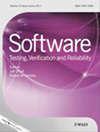会议虚拟化
IF 1.2
4区 计算机科学
Q3 COMPUTER SCIENCE, SOFTWARE ENGINEERING
引用次数: 0
摘要
由于2019冠状病毒病(COVID-19)的持续爆发,会议虚拟化分别在最近的过去、正在进行和即将进行的时期发生、正在发生和将要发生。一个正在进行的会议虚拟化的例子是ICSE 2020,这是软件工程领域最大的会议。ACM最近成立了ACM主席工作组,研究会议如何取代面对面会议;2020年5月,该工作组发布了虚拟会议最佳实践指南(https://www.acm.org/virtual-conferences)。视频会议和/或网络研讨会系统(如Zoom)的可用性使得被接受的会议论文的在线实时演示变得容易和低成本。人们可能会想,目前的现场演示技术和平台是否可以促进一些传播期刊论文的创新,超越目前期刊和会议之间合作的常见做法,例如期刊优先论文。例如,一个期刊可以考虑每年或每半年组织一次虚拟期刊峰会,让该期刊上被接受或发表的论文的作者以在线直播的方式展示他们的论文。事实上,在这些创新付诸行动之前,需要进行社区讨论。我们欢迎您对期刊论文传播的可能创新(特别是面对会议虚拟化)的想法,以及这些创新的潜在利弊。本期包含两篇论文。在第一篇论文中,Lucas R. Andrade, Patricia D. L. Machado和Wilkerson。L. Andrade解决了预测测试套件的故障检测能力的问题。前面已经观察到,尽管代码覆盖率经常被认为是重要的,但是测试套件所实现的实际覆盖率并不能很好地预测效率。为了解决这个问题,最近的工作引入了度量(操作覆盖的形式),它将代码覆盖与来自操作概要文件的信息结合起来,该概要文件模拟了系统的预期使用情况。本文报告了一个案例研究的结果,该案例研究考虑了46个版本的专有系统。为了提供测试套件有效性的估计,作者使用了发布后报告的错误数量(发现的越少,测试套件越有效)。有趣的是,我们发现在测试套件有效性的度量与两个版本的语句覆盖率之间存在负相关,但是与操作语句覆盖率之间的相关性更强。(洛里·l·波洛克推荐)。在第二篇论文中,刘延强、闫方歌、夏明远、齐正伟和刘雪介绍了TimelyRep,这是一种用于支持web的移动应用程序的高效且确定的重放工具。TimelyRep在面对移动交互的高输入率时,实现了程序状态的确定性重播和较低的重播延迟。特别是,TimelyRep包含一种机制,用于交付具有确定性序列、内容和延迟的HTTP响应流,而不需要修改浏览器核心或操作系统。TimelyRep还包含一种机制来控制JavaScript空间中的重放延迟,适用于移动web嵌入和传统web浏览器。本文报告了对两个具有复杂非确定性和密集用户输入的现实世界网页游戏应用程序的评估。评估结果表明,TimelyRep对于重现程序漏洞和保持低延迟对于触摸密集型网页游戏非常有用。(Robert Hierons推荐)。本文章由计算机程序翻译,如有差异,请以英文原文为准。
Conference Virtualization
Due to the ongoing COVID-19 outbreak, conference virtualization has happened, is happening, and will happen for the recent past, ongoing, and upcoming periods, respectively. An ongoing example of conference virtualization is ICSE 2020, the largest conference in software engineering. ACM has recently formed the ACM Presidential Task Force on What Conferences Can Do to Replace Faceto-Face Meetings; in May 2020, this task force released a guide to best practices on virtual conferences (https://www.acm.org/virtual-conferences). The availability of videoconferencing and/or Webinar systems such as Zoom has made online live presentations of accepted conference papers easy and low cost. One may wonder whether the current technology and platform availability for live presentations can facilitate some innovations of disseminating journal papers, going beyond the current common practice of partnership between journals and conferences, e.g., journal-first papers. For example, a journal may consider organizing a virtual journal summit every year or every half of a year for authors of accepted or published papers in that journal to present their papers in an online live manner. Indeed, community discussion is needed before these kinds of innovations are put into action. We welcome your thoughts on possible innovations of disseminating journal papers (especially in the face of conference virtualization), and these innovations’ potential pros and cons. This issue contains two papers. In the first paper, Lucas R. Andrade, Patricia D. L. Machado, and Wilkerson. L. Andrade address the problem of predicting the fault detection capability of a test suite. It has previously been observed that although code coverage is often seen as being important, the actual coverage achieved by a test suite is a poor predictor of effectiveness. To address this, recent work has introduced metrics (forms of Operational Coverage) that combine code coverage with information from an operational profile that models the expected usage of the system. This paper reports on the outcomes of a case study that considered 46 versions of a proprietary system. In order to provide an estimate of the effectiveness of a test suite, the authors used the number of post-release bugs reported (the fewer found, the more effective the test suite). Interestingly, it was found that there was a negative correlation between measures of test suite effectiveness with both versions of statement coverage but that the correlation was stronger with operational statement coverage. (Recommended by Lori L. Pollock). In the second paper, Yanqiang Liu, Fangge Yan, Mingyuan Xia, Zhengwei Qi, and Xue Liu present TimelyRep, an efficient and deterministic replay tool for web-enabled mobile applications. TimelyRep achieves deterministic replay of program states and low replay delays in face of the high input rate of mobile interaction. In particular, TimelyRep includes a mechanism for delivering an HTTP response stream with deterministic sequence, contents and latencies, without requiring modification of the browser core or the OS. TimelyRep also includes a mechanism to control replay delays in the JavaScript space, applicable for both the mobile web embeddings and traditional web browsers. This paper reports on an evaluation with two real-world web game applications with complicated non-determinism and intensive user inputs. The evaluation results show that TimelyRep is useful for recreating program bugs and maintaining low delays for touch-intensive web games. (Recommended by Robert Hierons).
求助全文
通过发布文献求助,成功后即可免费获取论文全文。
去求助
来源期刊

Software Testing Verification & Reliability
工程技术-计算机:软件工程
CiteScore
3.70
自引率
0.00%
发文量
34
审稿时长
>12 weeks
期刊介绍:
The journal is the premier outlet for research results on the subjects of testing, verification and reliability. Readers will find useful research on issues pertaining to building better software and evaluating it.
The journal is unique in its emphasis on theoretical foundations and applications to real-world software development. The balance of theory, empirical work, and practical applications provide readers with better techniques for testing, verifying and improving the reliability of software.
The journal targets researchers, practitioners, educators and students that have a vested interest in results generated by high-quality testing, verification and reliability modeling and evaluation of software. Topics of special interest include, but are not limited to:
-New criteria for software testing and verification
-Application of existing software testing and verification techniques to new types of software, including web applications, web services, embedded software, aspect-oriented software, and software architectures
-Model based testing
-Formal verification techniques such as model-checking
-Comparison of testing and verification techniques
-Measurement of and metrics for testing, verification and reliability
-Industrial experience with cutting edge techniques
-Descriptions and evaluations of commercial and open-source software testing tools
-Reliability modeling, measurement and application
-Testing and verification of software security
-Automated test data generation
-Process issues and methods
-Non-functional testing
 求助内容:
求助内容: 应助结果提醒方式:
应助结果提醒方式:


